tow OPEL ASTRA SALOON 2014 Owner's Guide
[x] Cancel search | Manufacturer: OPEL, Model Year: 2014, Model line: ASTRA SALOON, Model: OPEL ASTRA SALOON 2014Pages: 245, PDF Size: 7.12 MB
Page 198 of 245
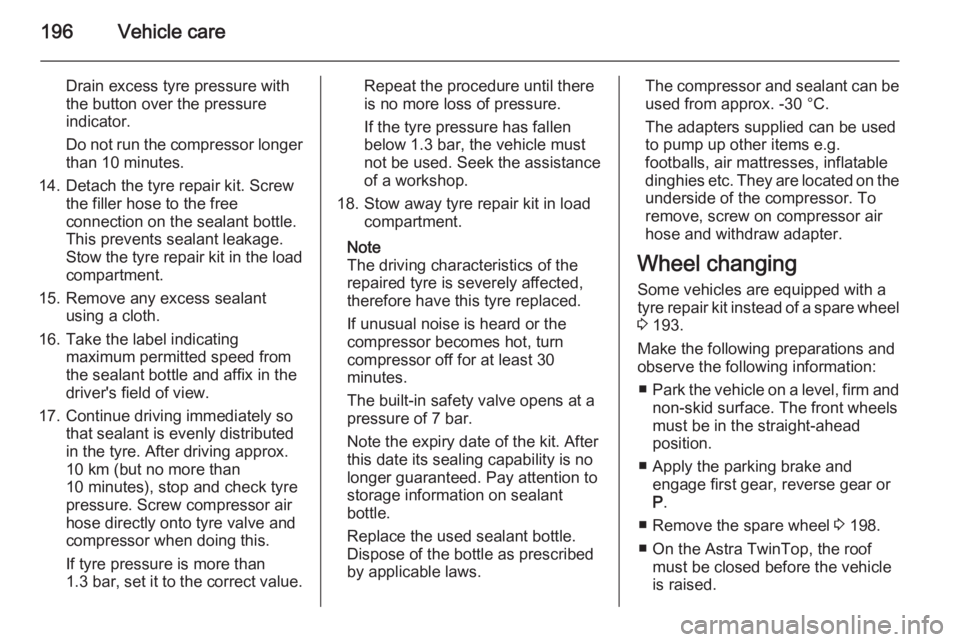
196Vehicle care
Drain excess tyre pressure with
the button over the pressure indicator.
Do not run the compressor longer than 10 minutes.
14. Detach the tyre repair kit. Screw the filler hose to the free
connection on the sealant bottle.
This prevents sealant leakage.
Stow the tyre repair kit in the load
compartment.
15. Remove any excess sealant using a cloth.
16. Take the label indicating maximum permitted speed from
the sealant bottle and affix in the
driver's field of view.
17. Continue driving immediately so that sealant is evenly distributed
in the tyre. After driving approx.
10 km (but no more than
10 minutes), stop and check tyre
pressure. Screw compressor air
hose directly onto tyre valve and
compressor when doing this.
If tyre pressure is more than
1.3 bar , set it to the correct value.Repeat the procedure until there
is no more loss of pressure.
If the tyre pressure has fallen
below 1.3 bar, the vehicle must
not be used. Seek the assistance
of a workshop.
18. Stow away tyre repair kit in load compartment.
Note
The driving characteristics of the
repaired tyre is severely affected,
therefore have this tyre replaced.
If unusual noise is heard or the
compressor becomes hot, turn
compressor off for at least 30
minutes.
The built-in safety valve opens at a
pressure of 7 bar.
Note the expiry date of the kit. After
this date its sealing capability is no
longer guaranteed. Pay attention to
storage information on sealant
bottle.
Replace the used sealant bottle. Dispose of the bottle as prescribed
by applicable laws.The compressor and sealant can be used from approx. -30 °C.
The adapters supplied can be used
to pump up other items e.g.
footballs, air mattresses, inflatable
dinghies etc. They are located on the underside of the compressor. To
remove, screw on compressor air
hose and withdraw adapter.
Wheel changing Some vehicles are equipped with a
tyre repair kit instead of a spare wheel 3 193.
Make the following preparations and
observe the following information:
■ Park the vehicle on a level, firm and
non-skid surface. The front wheels
must be in the straight-ahead
position.
■ Apply the parking brake and engage first gear, reverse gear or
P .
■ Remove the spare wheel 3 198.
■ On the Astra TwinTop, the roof must be closed before the vehicle
is raised.
Page 200 of 245
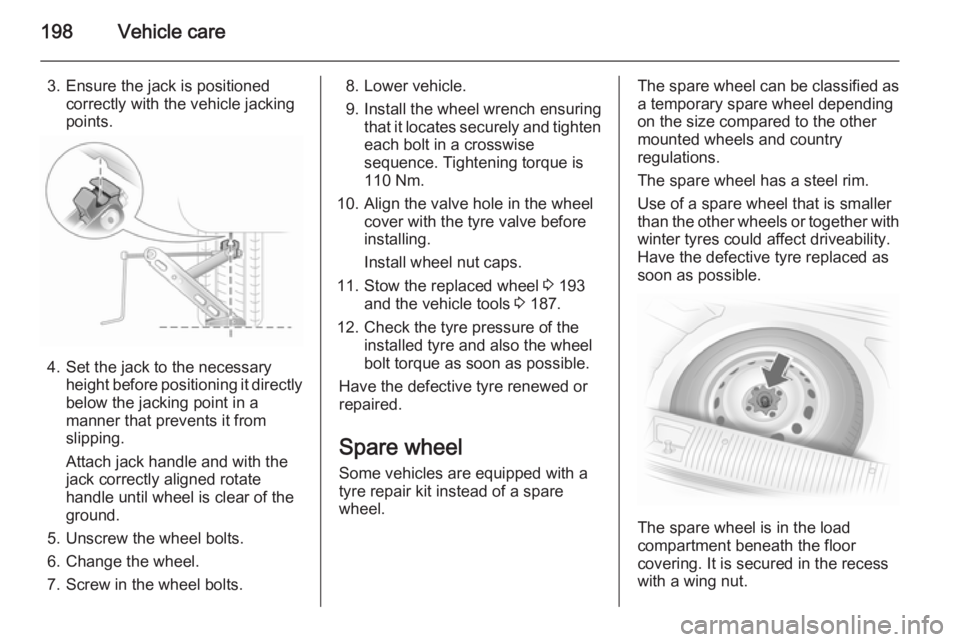
198Vehicle care
3. Ensure the jack is positionedcorrectly with the vehicle jacking
points.
4. Set the jack to the necessary height before positioning it directly
below the jacking point in a
manner that prevents it from
slipping.
Attach jack handle and with the
jack correctly aligned rotate
handle until wheel is clear of the
ground.
5. Unscrew the wheel bolts.
6. Change the wheel.
7. Screw in the wheel bolts.
8. Lower vehicle.
9. Install the wheel wrench ensuring that it locates securely and tighten
each bolt in a crosswise
sequence. Tightening torque is
110 Nm.
10. Align the valve hole in the wheel cover with the tyre valve before
installing.
Install wheel nut caps.
11. Stow the replaced wheel 3 193
and the vehicle tools 3 187.
12. Check the tyre pressure of the installed tyre and also the wheelbolt torque as soon as possible.
Have the defective tyre renewed or repaired.
Spare wheel
Some vehicles are equipped with a
tyre repair kit instead of a spare
wheel.The spare wheel can be classified as
a temporary spare wheel depending
on the size compared to the other
mounted wheels and country
regulations.
The spare wheel has a steel rim.
Use of a spare wheel that is smaller
than the other wheels or together with winter tyres could affect driveability.
Have the defective tyre replaced as
soon as possible.
The spare wheel is in the load
compartment beneath the floor
covering. It is secured in the recess
with a wing nut.
Page 201 of 245
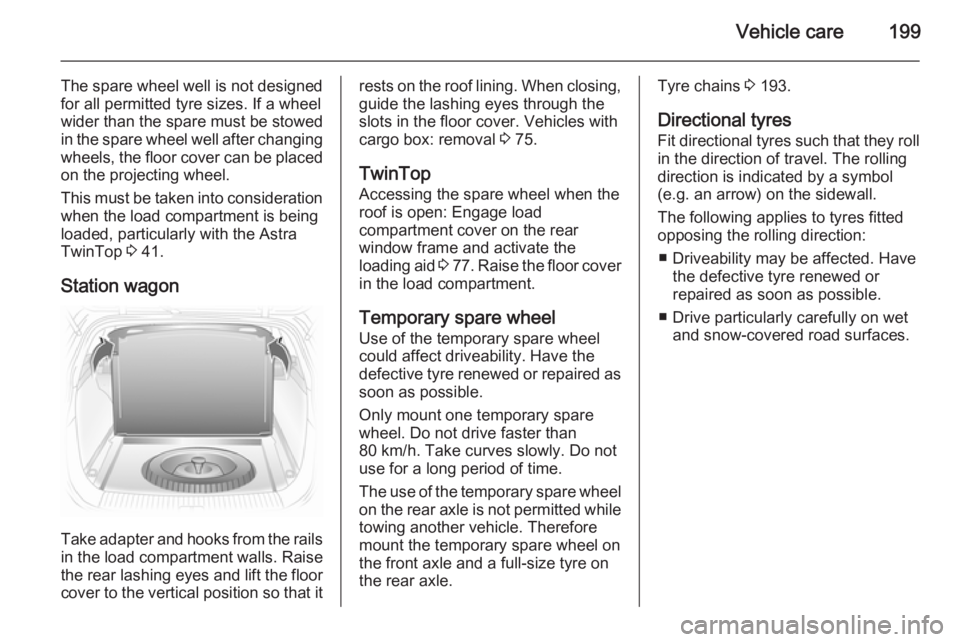
Vehicle care199
The spare wheel well is not designedfor all permitted tyre sizes. If a wheel
wider than the spare must be stowed
in the spare wheel well after changing
wheels, the floor cover can be placed on the projecting wheel.
This must be taken into consideration
when the load compartment is being
loaded, particularly with the Astra
TwinTop 3 41.
Station wagon
Take adapter and hooks from the rails
in the load compartment walls. Raise
the rear lashing eyes and lift the floor cover to the vertical position so that it
rests on the roof lining. When closing,
guide the lashing eyes through the
slots in the floor cover. Vehicles with
cargo box: removal 3 75.
TwinTop
Accessing the spare wheel when the roof is open: Engage load
compartment cover on the rear
window frame and activate the
loading aid 3 77 . Raise the floor cover
in the load compartment.
Temporary spare wheel
Use of the temporary spare wheel
could affect driveability. Have the
defective tyre renewed or repaired as soon as possible.
Only mount one temporary spare
wheel. Do not drive faster than
80 km/h. Take curves slowly. Do not
use for a long period of time.
The use of the temporary spare wheel
on the rear axle is not permitted while
towing another vehicle. Therefore
mount the temporary spare wheel on
the front axle and a full-size tyre on
the rear axle.Tyre chains 3 193.
Directional tyres Fit directional tyres such that they rollin the direction of travel. The rolling
direction is indicated by a symbol
(e.g. an arrow) on the sidewall.
The following applies to tyres fitted
opposing the rolling direction:
■ Driveability may be affected. Have the defective tyre renewed or
repaired as soon as possible.
■ Drive particularly carefully on wet and snow-covered road surfaces.
Page 203 of 245

Vehicle care201
3. Connect the black lead to thenegative terminal of the booster
battery.
4. Connect the other end of the black
lead to a vehicle grounding point,
such as the engine block or an
engine mounting bolt. Connect as far away from the discharged
battery as possible, however at
least 60 cm.
Route the leads so that they cannot
catch on rotating parts in the engine
compartment.
To start the engine: 1. Start the engine of the vehicle providing the jump.
2. After 5 minutes, start the other engine. Start attempts should be
made for no longer than
15 seconds at an interval of
1 minute.
3. Allow both engines to idle for approx. 3 minutes with the leads
connected.4. Switch on electrical consumers (e.g. headlights, heated rear
window) of the vehicle receiving
the jump start.
5. Reverse above sequence exactly when removing leads.Towing
Towing the vehicle
Disengage the cover at the bottom
and remove downwards.
The towing eye is stowed with the
vehicle tools 3 187.
Page 204 of 245

202Vehicle care
Screw in the towing eye as far as it will
go until it stops in a horizontal
position.
Attach a tow rope – or better still a tow
rod – to the towing eye.
The towing eye must only be used for towing and not recovering the vehicle.
Switch on ignition to release steering
wheel lock and to permit operation of
brake lights, horn and windscreen
wiper.
Open&Start system 3 22.
Transmission in neutral.
Caution
Drive slowly. Do not drive jerkily.
Excessive tractive force can
damage the vehicle.
When the engine is not running,
considerably more force is needed to
brake and steer.
To prevent the entry of exhaust gases from the towing vehicle, switch on the
air recirculation and close the
windows.
Vehicles with automatic transmission
must be towed facing forwards, not faster than 80 km/h nor further than
100 km. In all other cases and when
the transmission is defective, the front axle must be raised off the ground.
Seek the assistance of a workshop.
Manual transmission automated
3 142.
After towing, unscrew the towing eye
and refit the cover.
Towing another vehicle
Disengage cap at bottom and remove
downwards.
Page 205 of 245

Vehicle care203
For other models unclip locking tabs
downward and pull off the cover
upwards.
The towing eye is stowed with the
vehicle tools 3 187.
Screw in the towing eye as far as it will
go until it stops in a horizontal
position.
The lashing eye at the rear
underneath the vehicle must never be used as a towing eye.
Attach a tow rope – or better still a tow
rod – to the towing eye.
The towing eye must only be used for towing and not recovering a vehicle.
Caution
Drive slowly. Do not drive jerkily.
Excessive tractive force can
damage the vehicle.
After towing, unscrew the towing eye and refit the cover.
Version with cover: install by inserting the bottom lugs of the cover in the
bumper, folding and then press the
lugs at the top into place.
Appearance care
Exterior care
Locks The locks are lubricated at the factoryusing a high quality lock cylinder
grease. Use de-icing agent only when
absolutely necessary, as this has a
degreasing effect and impairs lock function. After using a de-icing agent, have the locks regreased by a
workshop.
Washing
The paintwork of your vehicle is
exposed to environmental influences. Wash and wax your vehicle regularly.
When using automatic car washes,
select a programme that includes
waxing.
Bird droppings, dead insects, resin,
pollen and the like should be cleaned
off immediately, as they contain
aggressive constituents which can
cause paint damage.
Page 207 of 245
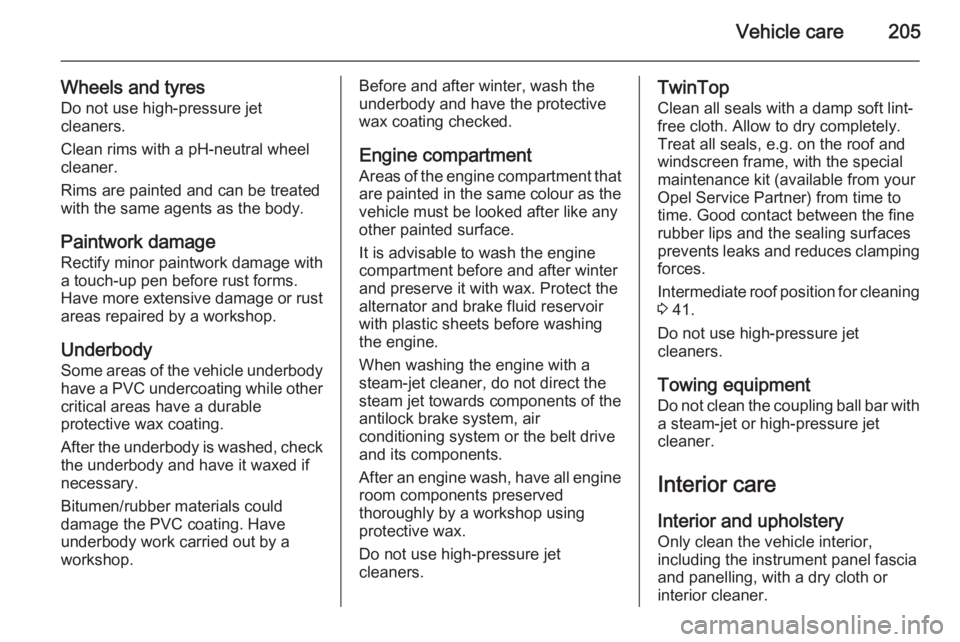
Vehicle care205
Wheels and tyresDo not use high-pressure jet
cleaners.
Clean rims with a pH-neutral wheel
cleaner.
Rims are painted and can be treated
with the same agents as the body.
Paintwork damageRectify minor paintwork damage witha touch-up pen before rust forms.
Have more extensive damage or rust
areas repaired by a workshop.
Underbody Some areas of the vehicle underbody
have a PVC undercoating while other critical areas have a durable
protective wax coating.
After the underbody is washed, check
the underbody and have it waxed if
necessary.
Bitumen/rubber materials could
damage the PVC coating. Have
underbody work carried out by a
workshop.Before and after winter, wash the
underbody and have the protective
wax coating checked.
Engine compartment
Areas of the engine compartment that
are painted in the same colour as the vehicle must be looked after like any
other painted surface.
It is advisable to wash the engine
compartment before and after winter
and preserve it with wax. Protect the
alternator and brake fluid reservoir
with plastic sheets before washing
the engine.
When washing the engine with a
steam-jet cleaner, do not direct the
steam jet towards components of the
antilock brake system, air
conditioning system or the belt drive
and its components.
After an engine wash, have all engine
room components preserved
thoroughly by a workshop using
protective wax.
Do not use high-pressure jet
cleaners.TwinTop
Clean all seals with a damp soft lint- free cloth. Allow to dry completely. Treat all seals, e.g. on the roof and
windscreen frame, with the special
maintenance kit (available from your
Opel Service Partner) from time to
time. Good contact between the fine
rubber lips and the sealing surfaces
prevents leaks and reduces clamping
forces.
Intermediate roof position for cleaning
3 41.
Do not use high-pressure jet
cleaners.
Towing equipment
Do not clean the coupling ball bar with
a steam-jet or high-pressure jet
cleaner.
Interior care Interior and upholsteryOnly clean the vehicle interior,
including the instrument panel fascia
and panelling, with a dry cloth or
interior cleaner.
Page 225 of 245
![OPEL ASTRA SALOON 2014 Owners Guide Technical data223
Heavy accessoriesAccessoriesSun roofTowing equipmentSplit rear seat backrestHeadlamp washer systemWeight [kg]23 (not on Saloon 4-door)
17 (Saloon 4-door)21 (not on TwinTop)
26 (TwinT OPEL ASTRA SALOON 2014 Owners Guide Technical data223
Heavy accessoriesAccessoriesSun roofTowing equipmentSplit rear seat backrestHeadlamp washer systemWeight [kg]23 (not on Saloon 4-door)
17 (Saloon 4-door)21 (not on TwinTop)
26 (TwinT](/img/37/58218/w960_58218-224.png)
Technical data223
Heavy accessoriesAccessoriesSun roofTowing equipmentSplit rear seat backrestHeadlamp washer systemWeight [kg]23 (not on Saloon 4-door)
17 (Saloon 4-door)21 (not on TwinTop)
26 (TwinTop)20 (Station wagon)
9 (Saloon 3-door / 5-door)2 (Saloon 4-door / 5-door)Vehicle dimensionsSaloon 5-doorSaloon 3-doorSaloon 4-doorStation wagonVanTwinTopLength [mm]424942904587451545154476Width without exterior mirrors [mm]175317531753175317531759Width with two exterior mirrors [mm]203220322033203220322021Height (without antenna) [mm]146014351458150015001411Length of load compartment floor [mm]81981990510851825805Load compartment width [mm]944944102710881103734Height of load compartment opening [mm]614555–766775–Wheelbase [mm]261426142703270327032614Turning circle diameter [m]11.2011.2011.5011.5011.5011.20
Page 234 of 245
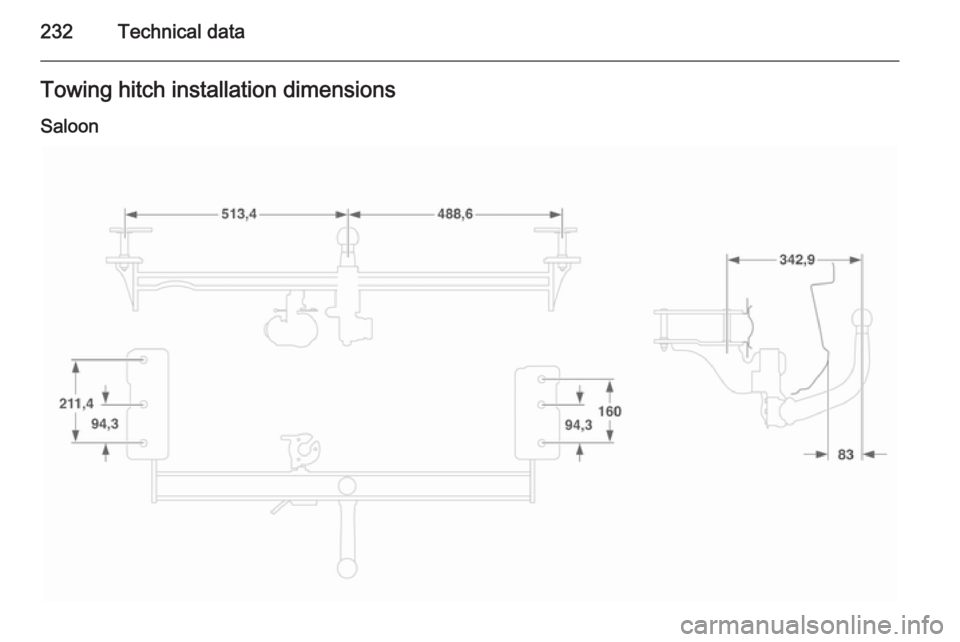
232Technical dataTowing hitch installation dimensionsSaloon
Page 241 of 245
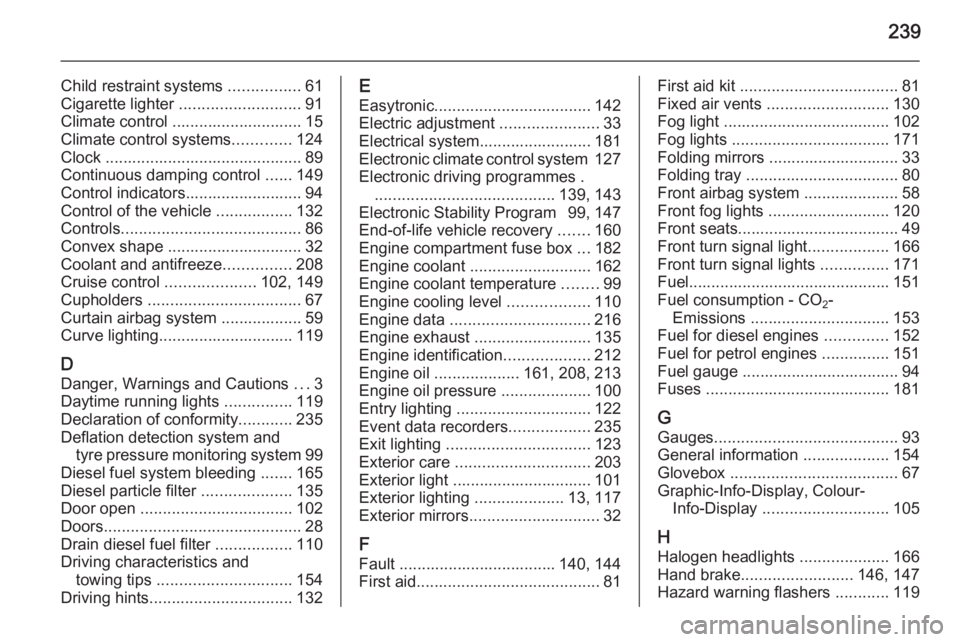
239
Child restraint systems ................61
Cigarette lighter ........................... 91
Climate control ............................. 15
Climate control systems .............124
Clock ............................................ 89
Continuous damping control ......149
Control indicators.......................... 94
Control of the vehicle .................132
Controls ........................................ 86
Convex shape .............................. 32
Coolant and antifreeze ...............208
Cruise control ....................102, 149
Cupholders .................................. 67
Curtain airbag system .................. 59
Curve lighting.............................. 119
D
Danger, Warnings and Cautions ...3
Daytime running lights ...............119
Declaration of conformity ............235
Deflation detection system and tyre pressure monitoring system 99
Diesel fuel system bleeding .......165
Diesel particle filter ....................135
Door open .................................. 102
Doors ............................................ 28
Drain diesel fuel filter .................110
Driving characteristics and towing tips .............................. 154
Driving hints ................................ 132E
Easytronic ................................... 142
Electric adjustment ......................33
Electrical system......................... 181
Electronic climate control system 127
Electronic driving programmes . ........................................ 139, 143
Electronic Stability Program 99, 147
End-of-life vehicle recovery .......160
Engine compartment fuse box ...182
Engine coolant ........................... 162
Engine coolant temperature ........99
Engine cooling level ..................110
Engine data ............................... 216
Engine exhaust .......................... 135
Engine identification ...................212
Engine oil ................... 161, 208, 213
Engine oil pressure ....................100
Entry lighting .............................. 122
Event data recorders ..................235
Exit lighting ................................ 123
Exterior care .............................. 203
Exterior light ............................... 101
Exterior lighting ....................13, 117
Exterior mirrors ............................. 32
F
Fault ................................... 140, 144
First aid ......................................... 81First aid kit ................................... 81
Fixed air vents ........................... 130
Fog light ..................................... 102
Fog lights ................................... 171
Folding mirrors ............................. 33
Folding tray .................................. 80
Front airbag system .....................58
Front fog lights ........................... 120
Front seats.................................... 49
Front turn signal light ..................166
Front turn signal lights ...............171
Fuel............................................. 151
Fuel consumption - CO 2-
Emissions ............................... 153
Fuel for diesel engines ..............152
Fuel for petrol engines ...............151
Fuel gauge ................................... 94 Fuses ......................................... 181
G
Gauges ......................................... 93
General information ...................154
Glovebox ..................................... 67
Graphic-Info-Display, Colour- Info-Display ............................ 105
H Halogen headlights ....................166
Hand brake ......................... 146, 147
Hazard warning flashers ............119